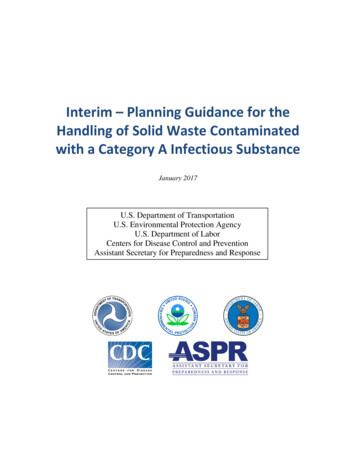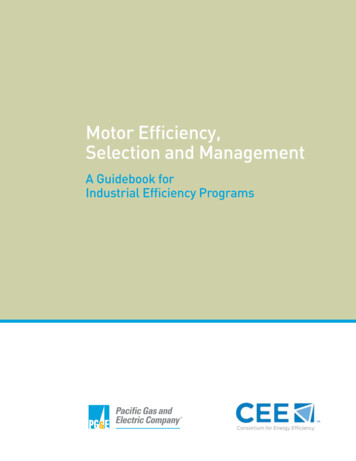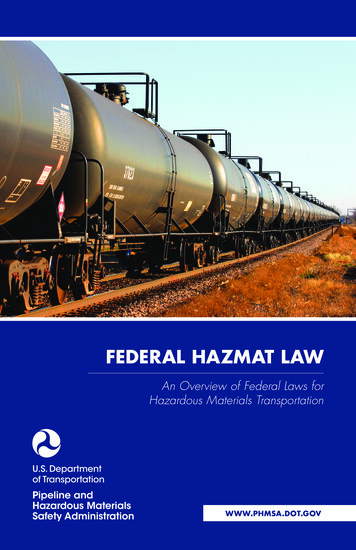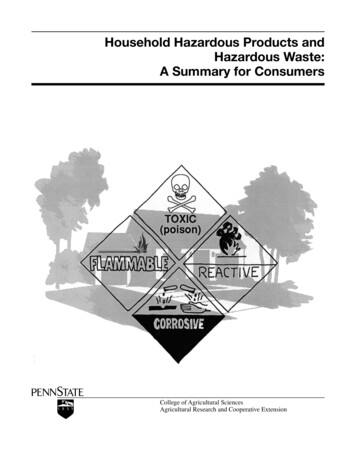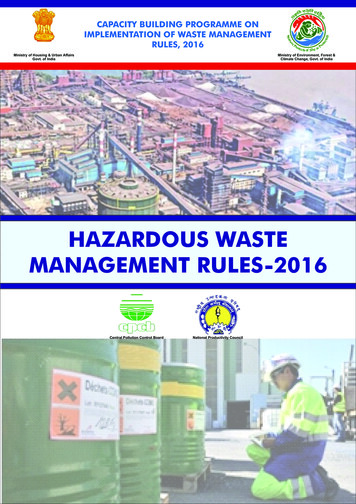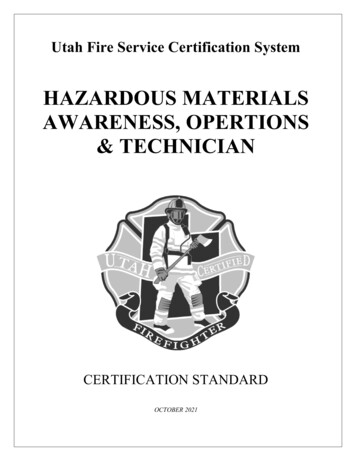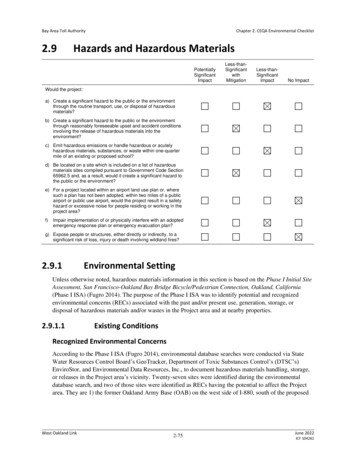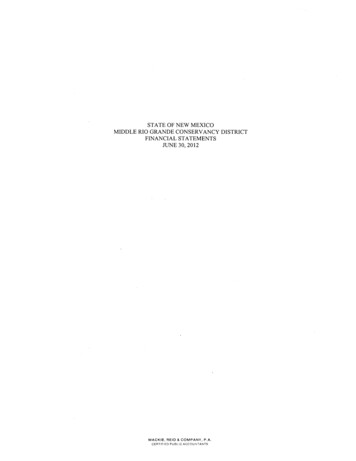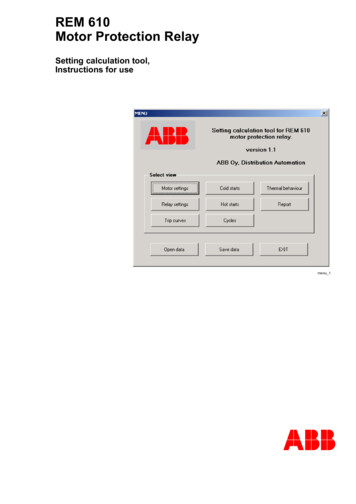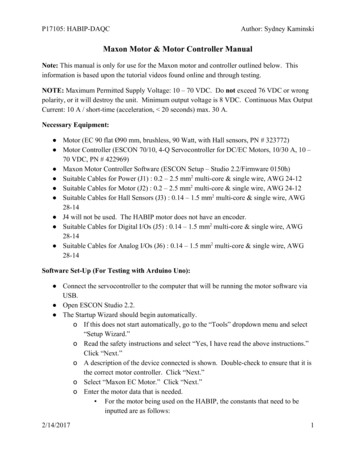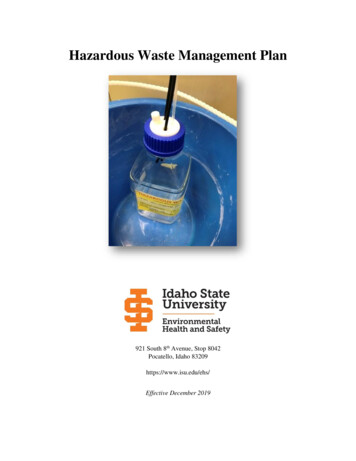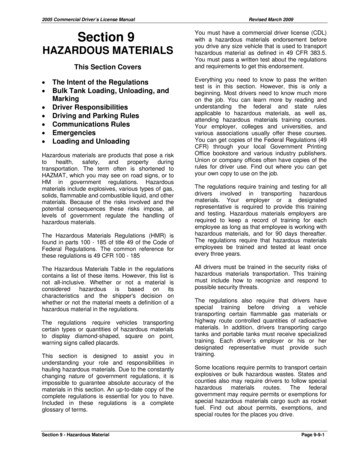
Transcription
2005 Commercial Driver’s License ManualSection 9HAZARDOUS MATERIALSThis Section Covers The Intent of the RegulationsBulk Tank Loading, Unloading, andMarkingDriver ResponsibilitiesDriving and Parking RulesCommunications RulesEmergenciesLoading and UnloadingHazardous materials are products that pose a n. The term often is shortened toHAZMAT, which you may see on road signs, or toHM in government regulations. Hazardousmaterials include explosives, various types of gas,solids, flammable and combustible liquid, and othermaterials. Because of the risks involved and thepotential consequences these risks impose, alllevels of government regulate the handling ofhazardous materials.The Hazardous Materials Regulations (HMR) isfound in parts 100 - 185 of title 49 of the Code ofFederal Regulations. The common reference forthese regulations is 49 CFR 100 - 185The Hazardous Materials Table in the regulationscontains a list of these items. However, this list isnot all-inclusive. Whether or not a material isconsideredhazardousisbasedonitscharacteristics and the shipper's decision onwhether or not the material meets a definition of ahazardous material in the regulations.The regulations require vehicles transportingcertain types or quantities of hazardous materialsto display diamond-shaped, square on point,warning signs called placards.This section is designed to assist you inunderstanding your role and responsibilities inhauling hazardous materials. Due to the constantlychanging nature of government regulations, it isimpossible to guarantee absolute accuracy of thematerials in this section. An up-to-date copy of thecomplete regulations is essential for you to have.Included in these regulations is a completeglossary of terms.Section 9 - Hazardous MaterialRevised March 2009You must have a commercial driver license (CDL)with a hazardous materials endorsement beforeyou drive any size vehicle that is used to transporthazardous material as defined in 49 CFR 383.5.You must pass a written test about the regulationsand requirements to get this endorsement.Everything you need to know to pass the writtentest is in this section. However, this is only abeginning. Most drivers need to know much moreon the job. You can learn more by reading andunderstanding the federal and state rulesapplicable to hazardous materials, as well as,attending hazardous materials training courses.Your employer, colleges and universities, andvarious associations usually offer these courses.You can get copies of the Federal Regulations (49CFR) through your local Government PrintingOffice bookstore and various industry publishers.Union or company offices often have copies of therules for driver use. Find out where you can getyour own copy to use on the job.The regulations require training and testing for alldrivers involved in transporting hazardousmaterials. Your employer or a designatedrepresentative is required to provide this trainingand testing. Hazardous materials employers arerequired to keep a record of training for eachemployee as long as that employee is working withhazardous materials, and for 90 days thereafter.The regulations require that hazardous materialsemployees be trained and tested at least onceevery three years.All drivers must be trained in the security risks ofhazardous materials transportation. This trainingmust include how to recognize and respond topossible security threats.The regulations also require that drivers havespecial training before driving a vehicletransporting certain flammable gas materials orhighway route controlled quantities of radioactivematerials. In addition, drivers transporting cargotanks and portable tanks must receive specializedtraining. Each driver’s employer or his or herdesignated representative must provide suchtraining.Some locations require permits to transport certainexplosives or bulk hazardous wastes. States andcounties also may require drivers to follow nt may require permits or exemptions forspecial hazardous materials cargo such as rocketfuel. Find out about permits, exemptions, andspecial routes for the places you drive.Page 9-9-1
2005 Commercial Driver’s License Manual9.1 – The Intent of the Regulations9.1.1 – Contain the MaterialTransporting hazardous materials can be risky.The regulations are intended to protect you, thosearound you, and the environment. They tellshippers how to package the materials safely anddrivers how to load, transport, and unload thematerial. These are called "containment rules."9.1.2 – Communicate the RiskTo communicate the risk, shippers must warndrivers and others about the material's hazards.The regulations require shippers to put hazardwarning labels on packages, provide propershipping papers, emergency response information,and placards. These steps communicate thehazard to the shipper, the carrier, and the driver.9.1.3 – Assure Safe Drivers and EquipmentIn order to get a hazardous materials endorsementon a CDL, you must pass a written test abouttransporting hazardous materials. To pass the test,you must know how to:Identify what are hazardous materials.Safely load shipments.Properly placard your vehicle in accordancewith the rules.Safely transport shipments.Learn the rules and follow them. Following therules reduces the risk of injury from hazardousmaterials. Taking shortcuts by breaking rules isunsafe. Non-compliance with regulations can resultin fines and jail.Inspect your vehicle before and during each trip.Law enforcement officers may stop and inspectyour vehicle. When stopped, they may check yourshipping papers, vehicle placards, and thehazardous materials endorsement on your driverlicense, and your knowledge of hazardousmaterials.Revised March 2009Uses the hazardous materials regulations todetermine the product’s:Proper shipping name.Hazard class.Identification number.Packing group.Correct packaging.Correct label and markings.Correct placards.Must package, mark, and label the materials;prepare shipping papers; provide emergencyresponse information; and supply placards.Certify on the shipping paper that the shipmenthas been prepared according to the rules(unless you are pulling cargo tanks supplied byyou or your employer).9.2.2 – The CarrierTakes the shipment from the shipper to itsdestination.Prior to transportation, checks that the shippercorrectly described, marked, labeled, andotherwise prepared the shipment fortransportation.Refuses improper shipments.Reports accidents and incidents involvinghazardous materials to the proper governmentagency.9.2.3 – The DriverMakes sure the shipper has identified, marked,and labeled the hazardous materials properly.Refuses leaking packages and shipments.Placards vehicle when loading, if required.Safely transports the shipment without delay.Follows all special rules about transportinghazardous materials.Keeps hazardous materials shipping papersand emergency response information in theproper place.9.2 – Hazardous MaterialsTransportation—Who Does What9.2.1 – The ShipperSends products from one place to another bytruck, rail, vessel, or airplane.Section 9 - Hazardous MaterialPage 9-9-2
2005 Commercial Driver’s License Manual9.3 – Communication Rules9.3.1 – DefinitionsSome words and phrases have special meaningswhen talking about hazardous materials. Some ofthese may differ from meanings you are used to.The words and phrases in this section may be onyour test. The meanings of other important wordsare in the glossary at the end of Section 9.A material's hazard class reflects the risksassociated with it. There are nine different hazardclasses. The types of materials included in thesenine classes are in Figure 9.1.Hazardous Materials xamplesMass ExplosionProjection HazardFire HazardMinor ExplosionVery ay FireworksAmmunitionBlasting AgentsExplosive DevicesFlammable le SolidsSpontaneouslyCombustibleDangerous WhenWetAmmonium Picrate,WettedWhite PhosphorusSodium5.15.2OxidizersOrganic PeroxidesAmmonium NitrateMethyl Ethyl KetonePeroxide6.1Poison osivesMiscellaneousHazardous MaterialsORM-D (OtherRegulated MaterialDomestic)Combustible LiquidsPotassium Cyanide-9-e-¾In a pouch on the driver's door, orIn clear view within immediate reach whilethe seat belt is fastened while driving, orOn the driver's seat when out of thevehicle.Shippers put diamond-shaped hazard warninglabels on most hazardous materials packages.These labels inform others of the hazard. If thediamond label won't fit on the package, shippersmay put the label on a tag securely attached to thepackage. For example, compressed gas cylindersthat will not hold a label will have tags or decals.Labels look like the examples in Figure 9.2.4.14.278¾¾Fluorine, CompressedGasoline6.2Shippers to describe hazardous materialscorrectly and include an emergency responsetelephone number on shipping papers.Carriers and drivers to quickly identifyhazardous materials shipping papers, or keepthem on top of other shipping papers and keepthe required emergency response informationwith the shipping papers.Drivers to keep hazardous materials shippingpapers:9.3.2 – Package LabelsFlammable Liquids6After an accident or hazardous materials spill orleak, you may be injured and unable tocommunicate the hazards of the materials you aretransporting. Firefighters and police can prevent orreduce the amount of damage or injury at thescene if they know what hazardous materials arebeing carried. Your life, and the lives of others,may depend on quickly locating the hazardousmaterials shipping papers. For that reason therules require:PropaneHelium-4.35Name of Class orDivisionRevised March 2009Anthrax VirusUraniumBattery FluidPolychlorinatedBiphenyls (PCB)Food Flavorings,MedicinesFuel OilFigure 9.1A shipping paper describes the hazardousmaterials being transported. Shipping orders, billsof lading, and manifests are all shipping papers.Figure 9.6 shows an example shipping paper.Section 9 - Hazardous MaterialExamples of HAZMAT Labels. Figure 9.2Page 9-9-3
2005 Commercial Driver’s License ManualRevised March 2009Appendix A to Section 172.101, the List ofHazardous Substances and ReportableQuantities.Appendix B to Section 172.101, the List ofMarine Pollutants.9.3.3 – Lists of Regulated ProductsPlacards. Placards are used to warn others ofhazardous materials. Placards are signs put on theoutside of a vehicle and on bulk packages, whichidentify the hazard class of the cargo. A placardedvehicle must have at least four identical placards.They are put on the front, rear, and both sides ofthe vehicle. See Figure 9.3. Placards must bereadable from all four directions. They are at least10 3/4 inches square, square-on-point, in adiamond shape. Cargo tanks and other bulkpackaging display the identification number of theircontents on placards or orange panels or whitesquare-on-point displays that are the same size asplacards.The Hazardous Materials Table. Figure 9.4shows part of the Hazardous Materials Table.Column 1 tells which shipping mode(s) the entryaffects and other information concerning theshipping description. The next five columns showeach material's shipping name, hazard class ordivision, identification number, packaging group,and required labels.Six different symbols may appear in Column 1 ofthe table.( )(A)(W)(D)(I)Examples of HAZMAT Placards. Figure 9.3Shows the proper shipping name, hazardclass, and packing group to use, even ifthe material doesn't meet the hazard classdefinition.Means the hazardous material describedin Column 2 is subject to the HMR onlywhen offered or intended for transport byair unless it is a hazardous substance orhazardous waste.Means the hazardous material describedin Column 2 is subject to the HMR onlywhen offered or intended for transportationby water unless it is a hazardoussubstance, hazardous waste, or marinepollutant.Means the proper shipping name isappropriate for describing materials fordomestic transportation, but may not beproper for international transportation.Identifies a proper shipping name that isused to describe materials in internationalIdentification numbers are a four-digit code usedby first responders to identify hazardous materials.An identification number may be used to identifymore than one chemical. The letters “NA or “UN”will precede the identification number. The UnitedStates Department of Transportation’s EmergencyResponse Guidebook (ERG) lists the chemicalsand the identification numbers assigned to them.There are three main lists used by shippers,carriers, and drivers when trying to identifyhazardous materials. Before transporting amaterial, look for its name on three lists. Somematerials are on all lists, others on only one.Always check the following lists:Section 172.101, the Hazardous MaterialsTable.Section 9 - Hazardous MaterialPage 9-9-4
2005 Commercial Driver’s License ManualRevised March 200949 CFR 172.101 Hazardous Materials TablePackaging (173. ***)SymbolsHazardous MaterialsDescription & ProperShipping NamesHazardClass 4)(5)(6)(7)(8A)(8B)(8C)AAcetaldehyde ammonia9UN1841III9IB8, IP6155204240Figure 9.4Appendix A to 49 CFR 172List of Hazardous Substances and Reportable QuantitiesHazardous SubstancesPhenyl mercaptan @Phenylmercury sphoric acidPhosphoric acid, diethyl4-nitrophenyl esterPhosphoric acid, lead saltReportable Quantity (RQ) Pounds(Kilograms)100 (45.4)100 (45.4)100 (45.4)10 (4.54)10 (4.54)100 (45.4) *5,000 (2270)100 (45.4)10 (.454)* Spills of 10 pounds or more must be reported.Figure 9.5transportation. A different shipping namemay be used when only domestictransportation is involved.Means this hazardous material describedin Column 2 is a generic shipping name. Agenericshippingnamemustbeaccompanied by a technical name on theshipping paper. A technical name is aspecific chemical that makes the producthazardous.Column 3 shows a material's hazard class ordivision, or the entry "Forbidden." Never transporta "Forbidden" material. Placard hazardousmaterials shipments based on the quantity andhazard class. You can decide which placards touse if you know these three things:Material's hazard class.Amount being shipped.Amount of all hazardous materials of allclasses on your vehicle.Column 2 lists the proper shipping names anddescriptions of regulated materials. Entries are inalphabetical order so you can more quickly find theright entry. The table shows proper shippingnames in regular type. The shipping paper mustshow proper shipping names. Names shown initalics are not proper shipping names.Column 4 lists the identification number for eachproper shipping name. Identification numbers arepreceded by the letters "UN" or "NA." The letters"NA" are associated with proper shipping namesthat are only used within the United States and toand from Canada. The identification number mustappear on the shipping paper as part of theshipping description and also appear on thepackage. It also must appear on cargo tanks and(G)Section 9 - Hazardous MaterialPage 9-5
2005 Commercial Driver’s License Manualother bulk packaging. Police and firefighters usethis number to quickly identify the hazardousmaterials.Column 5 shows the packing group (in Romannumeral) assigned to a material.Column 6 shows the hazard warning label(s)shippers must put on packages of hazardousmaterials. Some products require use of more thanone label due to a dual hazard being present.Column 7 lists the additional (special) provisionsthat apply to this material. When there is an entryin this column, you must refer to the federalregulations for specific information. The numbers1-6 in this column mean the hazardous material isa poison inhalation hazard (PIH). PIH materialshave special requirements for shipping papers,marking, and placards.Revised March 2009Appendix B is a listing of chemicals that are toxicto marine life. For highway transportation, this listis only used for chemicals in a container with acapacity of 119 gallons or more without a placardor label as specified by the HMR.Any bulk packages of a Marine Pollutant mustdisplay the Marine Pollutant marking (white trianglewith a fish and an “X” through the fish). Thismarking (it is not a placard) must also be displayedon the outside of the vehicle. In addition, a notationmust be made on the shipping papers near theShipping ntityColumn 8 is a three-part column showing thesection numbers covering the packagingrequirements for each hazardous material.Note: Columns 9 and 10 do not apply totransportation by highway.Appendix A to 49 CFR 172.101 - The List ofHazardousSubstancesandReportableQuantities. The DOT and the EPA want to knowabout spills of hazardous substances. They arenamed in the List of Hazardous Substances andReportable Quantities. See Figure 9.5. Column 3of the list shows each product's reportable quantity(RQ). When these materials are being transportedin a reportable quantity or greater in one package,the shipper displays the letters RQ on the shippingpaper and package. The letters RQ may appearbefore or after the basic description. You or youremployer must report any spill of these materials,which occurs in a reportable quantity.If the words INHALATION HAZARD appear on theshipping paper or package, the rules requiredisplay of the POISON INHALATION HAZARD orPOISON GAS placards, as appropriate. Theseplacards must be used in addition to otherplacards, which may be required by the product'shazard class. Always display the hazard classplacard and the POISON INHALATION HAZARDplacard, even for small amounts.Appendix B to 49 CFR 172.101 – List of MarinePollutantsSection 9 - Hazardous Material1cylinderHMRQ(“RQ”means thatthis is StreetNowhere,CODescriptionPage1 of 1Phosgene,2.3,UN1076Poison,InhalationHazard,Zone A25 lbsWeight(Phosgene is thepropershippingname from Column 2of the HazardousMaterialsTable.)(2.3 is the HazardClass from Column 3of the nNumberfromColumn 4 of theHazardous materialsTable.)This is to certify that the above named materials areproperly classified, described, packaged marked andlabeled, and are in proper condition for transportationaccording to the applicable regulations of the UnitedStates Department of hOctober 15,2003Carrier:Per:Date:SafetyFirstSpecial Instructions: 24 hour Emergency Contact,John Smith 1-800-555-5555Figure 9.6Page 9-6
2005 Commercial Driver’s License Manualdescription of the material:“Marine Pollutant”.9.3.4 – The Shipping PaperThe shipping paper shown in Figure 9.6 describesa shipment. A shipping paper for hazardousmaterials must include:Page numbers if the shipping paper has morethan one page. The first page must tell thetotal number of pages. For example, "Page 1of 4".A proper shipping description for eachhazardous material.A shipper's certification, signed by the shipper,saying they prepared the shipment accordingto the regulations.9.3.5 – The Item DescriptionIf a shipping paper describes both hazardous andnon-hazardous products, the hazardous materialswill be either:Described first.Highlighted in a contrasting color.Identified by an "X" placed before the shippingname in a column captioned "HM". The letters"RQ" may be used instead of "X" if a reportablequantity is present in one package.The basic description of hazardous materialsincludes the proper shipping name, hazard class ordivision, the identification number, and the packinggroup, if any, in that order. The packing group isdisplayed in Roman numerals and may bepreceded by "PG".Shipping name, hazard class, and identificationnumber must not be abbreviated unless specificallyauthorized in the hazardous materials regulations.The description must also show:The total quantity and unit of measure.The letters RQ, if a reportable quantity.If the letters RQ appear, the name of thehazardous substance.For all materials with the letter “G” (Generic) inColumn 1, the technical name of thehazardous material.Shipping papers also must list an emergencyresponse telephone number. The emergencyresponse telephone number is the responsibility ofthe shipper. It can be used by emergencyresponders to obtain information about anyhazardous materials involved in a spill or fire.Some hazardous materials do not need aSection 9 - Hazardous MaterialRevised March 2009telephone number. Youregulations to determinetelephone number.should check thewhich do need aShippers also must provide emergency responseinformation to the motor carrier for each hazardousmaterial being shipped. The emergency responseinformation must be able to be used away from themotor vehicle and must provide information on howto safely handle incidents involving the material. Itmust include information on the shipping name ofthe hazardous materials, risks to health, fire,explosion, and initial methods of handling spills,fires, and leaks of the materials.Such information can be on the shipping paper orsome other document that includes the basicdescription and technical name of the hazardousmaterial. Or, it may be in a guidance book such asthe Emergency Response Guidebook (ERG).Motor carriers may assist shippers by keeping anERG on each vehicle carrying hazardousmaterials. The driver must provide the emergencyresponse information to any federal, state, or localauthority responding to a hazardous materialsincident or investigating one.Total quantity must appear before or after the basicdescription. The packaging type and the unit ofmeasurement may be abbreviated. For example:10 ctns. Paint, 3, UN1263, PG II, 500 lbs.The shipper of hazardous wastes must put theword WASTE before the proper shipping name ofthe material on the shipping paper (hazardouswaste manifest). For example:Waste Acetone, 3, UN1090, PG II.A non-hazardous material may not be described byusing a hazard class or an identification number.9.3.6 – Shipper's CertificationWhen the shipper packages hazardous materials,he/she certifies that the package has beenprepared according to the rules. The signedshipper's certification appears on the originalshipping paper. The only exceptions are when ashipper is a private carrier transporting their ownproduct and when the package is provided by thecarrier (for example, a cargo tank). Unless apackage is clearly unsafe or does not comply withthe HMR, you may accept the shipper'scertification concerning proper packaging. SomePage 9-7
2005 Commercial Driver’s License Manualcarriers have additional rules about transportinghazardous materials. Follow your employer's ruleswhen accepting shipments.9.3.7 – Package Markings and LabelsShippers print required markings directly on thepackage, an attached label, or tag. An importantpackage marking is the name of the hazardousmaterial. It is the same name as the one on theshipping paper. The requirements for marking varyby package size and material being transported.When required, the shipper will put the following onthe package:The name and address of shipper orconsignee.The hazardous material's shipping name andidentification number.The labels required.It is a good idea to compare the shipping paper tothe markings and labels. Always make sure thatthe shipper shows the correct basic description onthe shipping paper, and verifies that the properlabels are shown on the packages. If you are notfamiliar with the material, ask the shipper tocontact your office.If rules require it, the shipper will put RQ, MARINEPOLLUTANT,BIOHAZARD,HOT,orINHALATION-HAZARD on the package. Packageswith liquid containers inside will also have packageorientation markings with the arrows pointing in thecorrect upright direction. The labels used alwaysreflect the hazard class of the product. If a packageneeds more than one label, the labels must beclose together, near the proper shipping name.9.3.8 – Recognizing Hazardous MaterialsLearn to recognize shipments of hazardousmaterials. To find out if the shipment includeshazardous materials, look at the shipping paper.Does it have:An entry with a proper shipping name, hazardclass, and identification number?A highlighted entry, or one with an X or RQ inthe hazardous materials column?Other clues suggesting hazardous materials:What business is the shipper in? Paint dealer?Chemical supply? Scientific supply house?Pest control or agricultural supplier?Explosives, munitions, or fireworks dealer?Are there tanks with diamond labels orplacards on the premises?Revised March 2009What type of package is being shipped?Cylinders and drums are often used forhazardous materials shipments.Is a hazard class label, proper shipping name,or identification number on the package?Are there any handling precautions?9.3.9 – Hazardous Waste ManifestWhen transporting hazardous wastes, you mustsign by hand and carry a Uniform HazardousWaste Manifest. The name and EPA registrationnumber of the shippers, carriers, and destinationmust appear on the manifest. Shippers mustprepare, date, and sign by hand the manifest.Treat the manifest as a shipping paper whentransporting the waste. Only give the wasteshipment to another registered carrier ng the shipment must sign by hand themanifest. After you deliver the shipment, keep yourcopy of the manifest. Each copy must have allneeded signatures and dates, including those ofthe person to whom you delivered the waste.9.3.10 – PlacardingAttach the appropriate placards to the vehiclebefore you drive it. You are only allowed to movean improperly placarded vehicle during anemergency, in order to protect life or property.Placards must appear on both sides and both endsof the vehicle. Each placard must be:Easily seen from the direction it faces.Placed so the words or numbers are level andread from left to right.At least three inches away from any othermarkings.Kept clear of attachments or devices such asladders, doors, and tarpaulins.Kept clean and undamaged so that the color,format, and message are easily seen.Be affixed to a background of contrastingcolor.The use of “Drive Safely” and other slogans isprohibited.The front placard may be on the front of thetractor or the front of the trailer.To decide which placards to use, you need toknow:The hazard class of the materials.The amount of hazardous materials shipped.The total weight of all classes of hazardousmaterials in your vehicle.9.3.11 – Placard TablesSection 9 - Hazardous MaterialPage 9-8
2005 Commercial Driver’s License ManualPlacard Table 1Any AmountIF YOUR VEHICLECONTAINS ANYAMOUNT OF 1.1 Mass Explosives1.2 Project Hazards1.3 Mass Fire Hazards2.3 Poisonous/ToxicGases4.3 Dangerous WhenWet5.2 (Organic Peroxide,Type B, liquid or solid,Temperaturecontrolled)6.1 (Inhalation hazardzone A & B only)7 (Radioactive YellowIII label only)PLACARD AS Explosives 1.1Explosives 1.2Explosives 1.3Poison GasDangerous When WetOrganic PeroxidePoison/toxic inhalationRadioactiveThere are two placard tables, Table 1 and Table 2.Table 1 materials must be placarded whenever anyamount is transported. See Figure 9.7.Except for bulk packaging, the hazard classes inTable 2 need placards only if the total amounttransported is 1,001 pounds or more including thepackage. Add the amounts from all shippingpapers for all the Table 2 products you have onboard. See Figure 9.8Figure 9.7You may use DANGEROUS placards instead ofseparate placards for each Table 2 hazard classwhen:You have 1,001 pounds or more of two ormore Table 2 hazard classes, requiringdifferent placards, andYou have not loaded 2,205 pounds or more ofany Table 2 hazard class material at any oneplace. (You must use the specific placard forthis material.)The dangerous placard is an option, not arequirement. You can always placard for thematerials.Revised March 2009If the words INHALATION HAZARD are on theshipping paper or package, you must displayPOISON GAS or POISON INHALATION placardsin addition to any other placards needed by theproduct's hazard class. The 1,000 pound exceptiondoes not apply to these materials.Materials with a secondary hazard of dangerouswhen wet must display the DANGEROUS WHENWET placard in addition to any other placardsneeded by the product’s hazard class. The 1,000pound exception to placarding does not apply tothese materials.Placard Table 21,001 Pounds Or MoreCategory of Material(Hazard class or divisionPlacard Namenumber and additionaldescription, asappropriate)1.4 Minor Explosion1.5 Very Insensitive1.6 Extremely Insensitive2.1 Flammable Gases2.2 Non- Flammable Gases3 Flammable LiquidsCombustible Liquid4.1 Flammable Solids4.2 SpontaneouslyCombustible5.1 OxidizersExplosives 1.4Explosives 1.5Explosives 1.6Flammable GasNon-Flammable Gas.FlammableCombustible*Flammable SolidSpontaneouslyCombustibleOxidizer5.2 (other than organicperoxide, Type B, liquid orsolid, TemperatureControlled)Organic Peroxide6.1 (other than inhalationhazard zone A or B)Poison6.2 Infectious Substances(None)8 CorrosivesCorrosive9 Miscellaneous HazardousClass 9**MaterialsORM-D(None)* FLAMMABLE may be used in place of aCOMBUSTIBLE on a cargo tank or portable tank.** Class 9 Placard is not required for domestictransportation.Figure 9.8Placards used to identify the primary or subsidiaryhazard class of a material must have the hazardclass or division number displayed in the lowercorner of the placard. Permanently affixedsubsidiary hazard placards without the hazardclass number may be used as long as they staywithin color specifications.Section 9 - Hazardous MaterialPlacards may be displayed for hazardous materialseven if not required so long as the placardidentifies the hazard of the
hazardous materials. The Hazardous Materials Regulations (HMR) is found in parts 100 - 185 of title 49 of the Code of Federal Regulations. The common reference for these regulations is 49 CFR 100 - 185 The Hazardous Materials Table in the regulations contains a list of these items. However, this list is not all-inclusive. Whether or not a .
